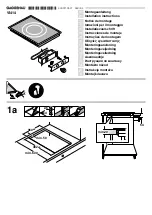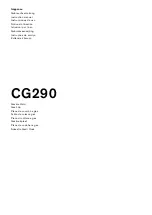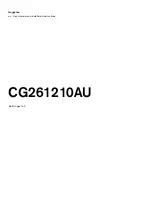
7
225178
A The base of the cookware is too thin. On heating up it
bends, resulting in increased energy consumption and
an uneven distribution of heat.
B The cookware is too large or too small. A pot which is
too small or a top which has not been put on properly
will waste energy.
C Suitable cookware.
Hints for cookware and for cooking
Below you will find some useful hints on how to use your
new hob and your cookware efficiently and economically.
The basic principle is:
The better your cookware, the lower your consumption of
energy!
• Good pots are characterised by a smooth, strong base.
Uneven pots result in a higher consumption of energy and
longer cooking times.
• When buying pots pay attention to the fact that it is fre-
quently the top diameter of the pot that is indicated. This
is often bigger than the base of the pot.
• Due to the closed cooking cavity and over-pressure, pres-
sure cookers are particularly economical concerning time
and energy consumption. Short cooking times preserve
vitamins.
• Always ensure that there is a sufficient amount of liquid in
a pressure cooker, since the hotplate and the pot may be
damaged if the liquid dries up.
• Heat transmission is optimal if the base of the pot and the
hotplate are the same size and the pot is placed in the
middle of the hotplate.
• Pots and pans may be larger in diameter than a hotplate,
but not smaller, since this would result in more heat loss,
and spills or dirt may burn and stick. Whenever possible
close pots with a tight-fitting lid.
• Use a suitable pot for the quantity of food being cooked.
A big pot with hardly any food in it will use a lot of energy.
• When using special cookware, please also observe the
manufacturer’s instructions for use.
unsuitable
wrong
optimal
Hotplate
Stainless steel hob
Stainless steel brim
Cleaning and Care
Caution!
• The hob must not be cleaned with a superheated or
steam cleaner.
• Switch off the hob and let it cool down before cleaning.
• Do not place wet pots or steamed lids on the hotplates,
the hotplates are sensitive to moisture.
• Do not let hot pots cool down on unused hotplates,
this might cause condensed water to induce corrosion.
Stainless steel hob
For cleaning the surface only use mild detergents (soap
water) and a soft, non-scouring sponge. To remove
persistent heavy dirt soak the dirt first with a wet sponge. Do
not use scouring or solvent detergents. They may damage
the surface.
Hotplates
Always clean any dirt from the four hotplates after use. For
light amounts of dirt use a damp cloth with dishwater. To
clean off more persistent dirt use soaped steel wool or
scouring detergents. After the cleaning always dry the
hotplates thoroughly.
Salty liquids, spilled cooking or moisture can damage the
hotplates. The hotplates should therefore always be cleaned
and dried after use.
To ensure optimal care for the hotplates we recommend
that you use some sewing machine lubricant regularly, or
any detergent or recommended cleaners. Never use butter,
bacon fat or similar agents that might cause corrosion.
Slightly warm hotplates accelerate cleaning as the cleaner
will permeate more quickly.
The hotplates´ stainless steel brim might take on a slightly
yellow colour through the thermal stress.
This is a mere physical change of colour that can be remo-
ved by recommended metal detergents and cleaners.
Do not use abrasive or scouring cleaners for the stainless
steel brim, as they will cause scratches.























